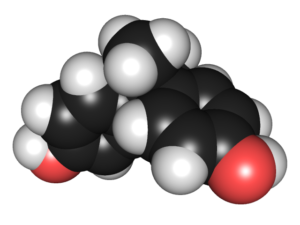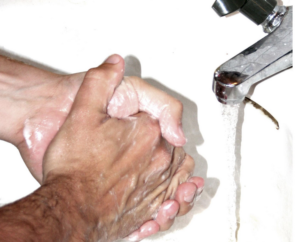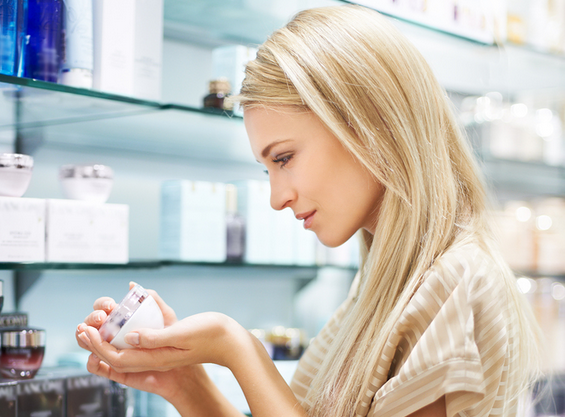Did you know that there are more than 80,000 chemicals currently being used in the United States and only a fraction of them have been tested to determine their effects on human health. Only 200 man-made chemicals have been tested for safety since 1976!
Women are more at risk because they use more personal care products than men and, on an average, are exposed to nearly 170 chemicals daily. Pregnant women have an increased risk and the toxins can be passed onto the baby in vitro and also are evident in breast milk. Studies have identified nearly 300 contaminants in the umbilical cord blood of newborns.
 Of the 10% of all ingredients used in cosmetics and tested for safety, 33% have been linked to cancer; nearly 50% contain harmful ingredients to the reproductive system and the development of a baby, and 60% are hormone disruptors. Remember that skin is the body’s largest organ and our body absorbs nearly two-thirds of what we put on it.
Of the 10% of all ingredients used in cosmetics and tested for safety, 33% have been linked to cancer; nearly 50% contain harmful ingredients to the reproductive system and the development of a baby, and 60% are hormone disruptors. Remember that skin is the body’s largest organ and our body absorbs nearly two-thirds of what we put on it.
The government really doesn’t do very much to protect people as there have, until recently, been no federal laws making cosmetic companies responsible for getting approval for their products. While the European Union has banned 1,300 chemicals from personal care products; the US has outlawed only 11.
There is a new bill Personal Care Products Safety Act that gives the FDA more authority to regulate the cosmetics industry. This could be good news and congratulations go to Senators Feinstein from California and Collins from Maine for introducing it. But there is a flaw! The new bill allows manufacturers to prove the safety of their ingredients by using science that is funded by the cosmetic industry. Here is a recent letter written by reputable personal care product manufacturers urging legislators to make the modifications necessary for there to be the changes that are needed.
Get involved! You can help have your voice heard here.
Following is a list of the major ones to avoid, although there are other potentially nasty culprits.
Avobenzone – Used in sunscreens. Generates free radicals that produce oxidative stress that can lead to cancer. Hormone disruptor, reproductive abnormalities, allergies.
Benzalkonium Chloride – Used in antibacterial soaps, sanitizers, wipes, nasal sprays, contact lens solution. According to Cosmetic Safety Database there is evidence that it is a toxicant for immune, skin and respiratory systems.
Benzophenone – Used in lip balms, nail polish, foundations, baby sunscreens, shampoo, conditioner, hair spray, moisturizers, and foundation. Concerns include that it could cause cancer, is a hormone disruptor and is toxic to developmental and reproductive systems.
BHA and BHT Used as preservatives in cosmetics. Endocrine and hormone disruptor, toxic to organs, negatively affects developmental and reproductive systems. Also can promote skin allergies.
Butylene Glycol Is derived from petroleum and is used as a preservative, solvent and humectant. Side effects include skin irritation, dermatitis, hives, depression and drowsiness.
Coal Tar Yep, just what the name says…this beauty ingredient is made from burning coal. It is used in shampoos and scalp treatments, soaps, hair dyes and lotions. But beware because it makes skin more sensitive to sunlight, produces tumors and has been associated with cancers of the lungs, bladder, kidney and digestive tract.
Diazolidinyl Urea Is used in cosmetics, skin care products, shampoos, conditioners, baby wipes, bubble baths. It is known to release formaldehyde, cause irritation and have negative effects on reproduction.
Ethylenediaminetetraacetic Acid (EDTA) Used in shampoos, skin creams and deodorants. Depletes vitamins and minerals in the body, can lower blood sugar, toxic to the body and can lead to kidney damage.
Ethanolamines (MEA/DEA/TEA) Used in cosmetic (including eyeliner, mascara, eye shadows, blush, and personal care items including soaps, shampoos, conditioners, lotions, waxes, shaving creams. Is a carcinogen and has been linked to cancers, liver & kidney toxicity, and abnormalities in male reproductive health, could effect memory function and brain development in children.
FD&C Colors & Pigments They are derived from petroleum and can also include antifreeze to help retain color. Linked to causing tumors, negatively impacting organs, prompting allergic reactions and triggering inflammation.
Formaldehyde, known as a human carcinogen this product is not only present as a preservative in numerous cosmetics but also in kid’s personal care items. Here are some of the ways that the cosmetic industry uses formaldehyde-releasing chemicals under different chemical names including: DMDM Hydantoin, Imidazolidinyl Urea, Diazolidinyl Urea, Quaternium-15 , Bronopol (2-bromo-2-nitropropane-1, 3-diol) 5 Bomos-5-nitro-1, 3-dioxane, Hydroxymethlglycinate. Side effects include skin irritation, toxicity and are cancer-causing carcinogens.
Hydroquinone Used as a stabilizer, oxidizing agent and also commonly used in skin lighteners. It is linked to cancer and organ-system toxicity.
Methylisothiazolinone (MIT) and Methylchloroisothiazolinone Used as an antibacterial and preservative in numerous liquid personal products including moisturizers and even baby shampoo. They have been linked to lung toxicity, shown to cause brain cell damage, increased risk of seizures, visual abnormalities and skin irritation.
Oxybenzone – Used in sunscreens. Acts as a hormone disruptor, associated with endometriosis in women, can cause skin allergies.
Parabens (Butyl Paraben, Ethyl Paraben, Isobutyl Paraben, Methyl Paraben, Propyl Paraben and others. Used as preservatives in cosmetic products including makeup, moisturizers, hair care products, shaving products and more. They have been linked to breast cancer and have been shown to negatively effect testosterone levels.
Phthalates. Found in cosmetics including nail polish, perfume and hair spray. Exposure can affect reproductive organs, particularly in prepubescent males. Have been linked to breast cancer, other cancers and can also disrupt hormones.
Polyethylene Glycol (PEG compounds) They come from petroleum and are used in cosmetics and hair care products as thickeners, solvents, softeners and moisture-carriers. They have been classified as a carcinogenic particularly because they contain the highly toxic ethylene oxide.
Sodium Lauryl Sulfate (SLS) and Sodium Laureth Sulfate (SLES) Commonly used in shampoo, body/face wash and often toothpaste to produce foam. Users can develop an allergic reaction after using it for a long time. Additionally they are oftentimes contaminated with 1,4 dioxane which is a known carcinogen. In testing exposure resulted in eye damage, difficulty breathing, diarrhea, skin irritation and were proven harmful to the immune system.
Synthetic Flavor and Fragrance Man made chemical compounds. Keep in mind almost 100% are derived from petroleum and other toxins synthesized in a lab. Side effects include everything from headaches, fatigue, and nausea and are capable of causing cancer, nervous system disorders and even birth defects.
Toluene is used in hair dyes and nail products. It is a central nervous system depressant that can cause headaches, nausea, dizziness, confusion and aspiration of the lungs. It has a main effect on the brain and central nervous systems but has also shown to be harmful to the liver, kidneys and lungs.
Triclosan and Triclocarban Are used as an antibacterial and anti-fungal agent in cosmetics and toothpaste. A huge win for the US population is that recently the FDA issued a rule banning the use of triclosan and triclocarban in hand and body washes.  Unfortunately the ban only applies to consumer products not to antibacterial soaps used in hospitals and other public locations. Still, look for these on the label and avoid them because some companies, including Dial are still using it as an ingredient.
Unfortunately the ban only applies to consumer products not to antibacterial soaps used in hospitals and other public locations. Still, look for these on the label and avoid them because some companies, including Dial are still using it as an ingredient.
Some of these ingredients are also found in food items so be on the lookout for them when you read the labels and become more informed.
There are alternatives. I would recommend that you research product lines and specific items through this free resource to find what is best for you. Additionally, I will be starting to include more personal skin care product reviews in the coming months.
If you would like to receive my handy pocket guide to take along when shopping for cosmetics, please sign up for my newsletter and email info@veginoc.com and put “POCKET GUIDE” in the subject line. Please make sure to include your name and mailing address.*
*Your information will be kept confidential and not shared with any third parties.







